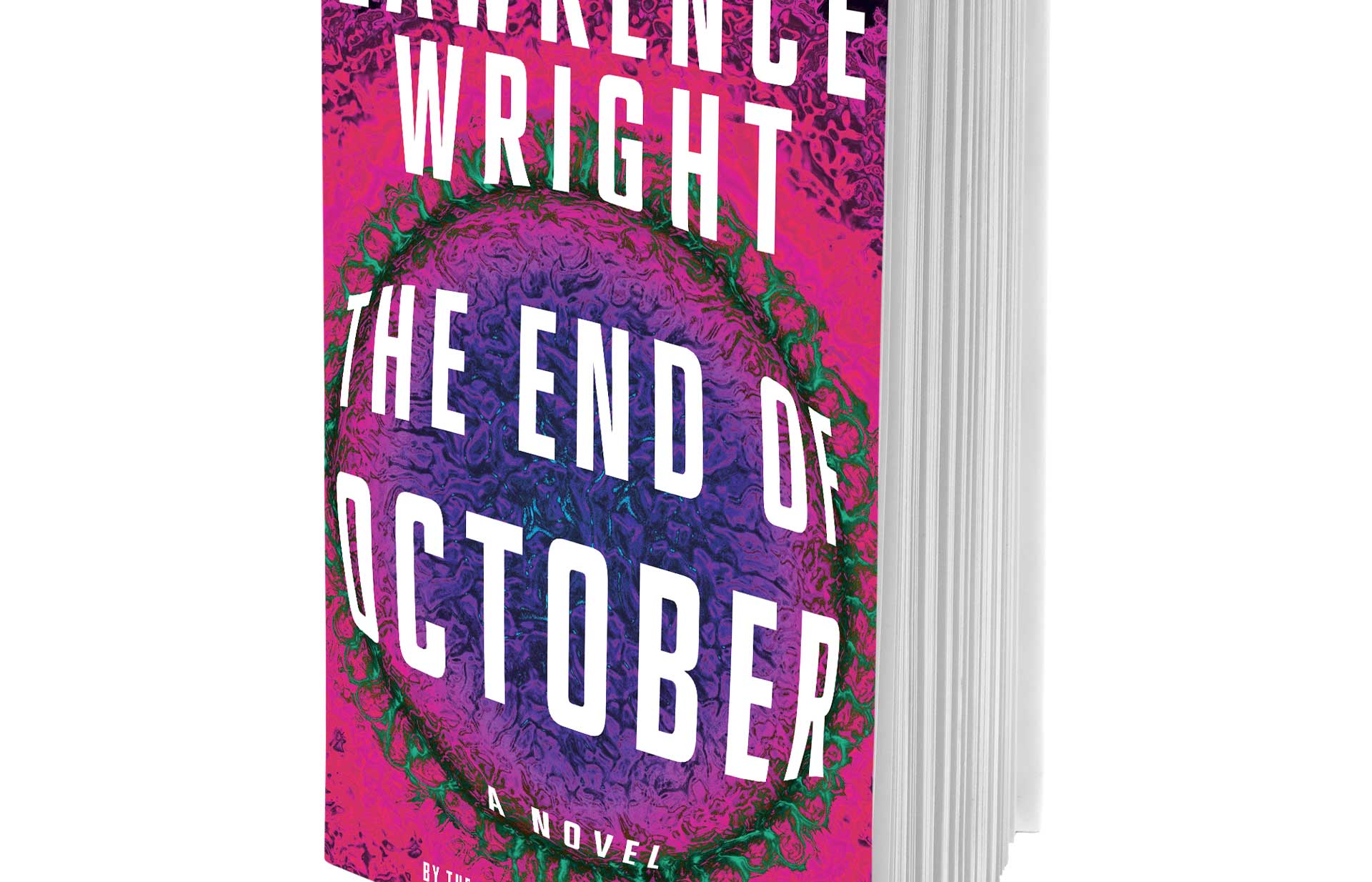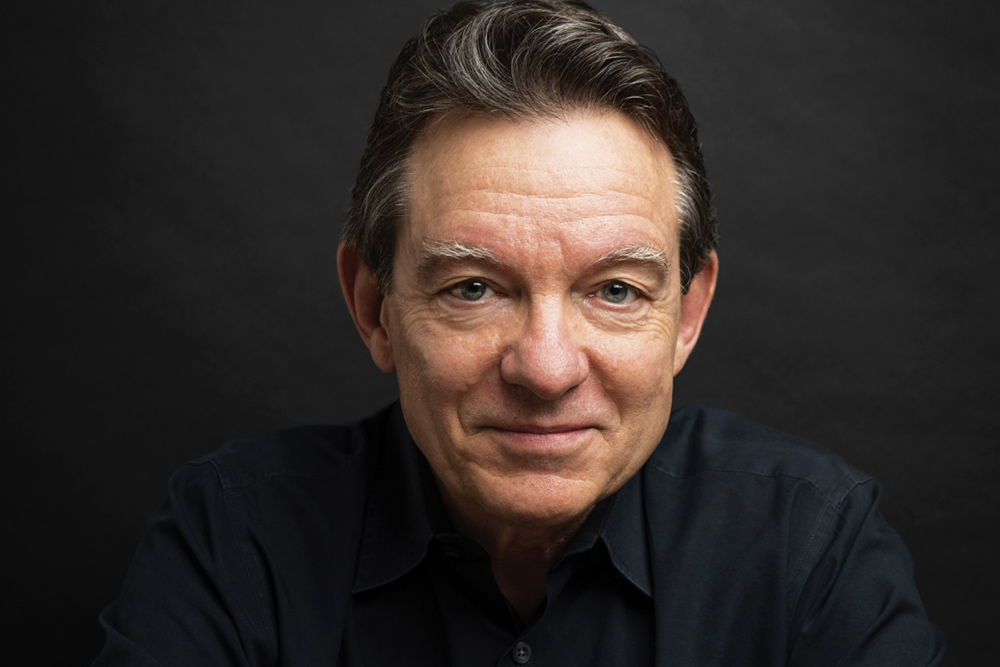再现“神预言”:小说《十月末》何以完美预测疫情走向
劳伦斯·赖特已经写了10本非虚构类文学书籍了,包括深度揭秘山达基教的《拨开迷雾:山达基教、好莱坞与信仰囚笼》,和讲述“911”事件的“塔影蜃楼:基地组织与通向“911”之路》等。不久之前,这位《纽约客》杂志的特约撰稿人又出版了一部引人入胜的作品,这本书主题也十分应景——一种神秘的、致命的新型病毒正在横扫地球。
只不过这一次,故事是以小说的形式呈现的。
如果这本书是在去年这个时候,或者哪怕是在几个月之前出版的,那么对于喜欢架空系小说的读者来说,这本名叫《十月末》的惊悚小说应该还是满有意思的。(只不过考虑到小说的主题,它可能不适合在旅行的时候读。)
然而随着世界进入“疫情时代”,它已经不再是一本架空小说了,但它仍然是一个扣人心弦的故事。小说讲述的是世界爆发了一种新型流感病毒,它以野火燎原之势席卷全球,并且很有可能导致全球经济进入停滞状态。在这种情况下,一个名叫亨利·帕森斯的医生辗转于世界各地,追踪这种病毒——这位主角的人设有点像《达芬奇密码》的主角罗伯特·兰登。很多读者在读这本书的时候,估计心中都在祈祷真实世界里能出现主角这样的英雄。
《财富》近日采访了赖特,请他介绍了这本书的灵感来源,他对传染病学的研究过程,以及他为什么能在疫情发生之前,就在书中预言了很多今天正在发生的事。(和很多在今年春天出书的作家一样,由于全美各地的书店都处于关闭状态,这本书的上市时间也重新做了调整。新书发布活动已经通过Zoom和EventBrite等线上渠道举行。)
为清晰起见,以下采访稿有删节。(放心,没有剧透。)

《财富》:书中引用了很多最近发生的真实的地缘政治和公共卫生事件,而且故事的背景十分贴近当下,更诡异的是,书中的很多情节甚至与真实世界的情况不谋而合。所以我必须要问,你是什么时候开始写这本书的?你的灵感来源是什么?
赖特:这本书一开始其实是我10年前为英国导演雷利·史考特写的一个剧本。当时我还没有架构好整个故事,坦率地说,我没有做足够的研究。不过瘟疫大爆发的创意一直萦绕在我的心里。2017年,我决定把它写成小说。这一次,我像是在非虚构类文学作品或者像是在为《纽约客》杂志写报道时一样,对流行病进行了认真的研究,并且请教了一些终身从事罕见病研究的专家,从而使这个故事变得更加自然。
以前人们可能对于流感毒株、疫苗这类的术语并不熟悉,但现在不同了。你的研究过程是怎样的?你是怎样认识世界卫生组织和政府机构的专家的?
我很有幸地与医学界的一些伟大的人物进行了交流。哥伦比亚大学感染与免疫中心主任伊恩·利普金是我最早打电话联系的专家之一,他让我参观了他的实验室,并且让他的一名助手教我他们是如何对病毒进行测序的。辉瑞公司病毒疫苗部门的首席科学家菲利普·多米茨教了我有关疫苗研发的知识。美国国家卫生研究院的免疫学家和疫苗专家巴尼·格雷汗姆医生帮我解决了一些我自己在小说里设置的医学难题。美国国家卫生研究院、国家变态反应与传染病研究所的研究员延斯·库恩也带我参观了他的实验室,他不仅传授了我科学知识,还给我讲了研究人员在动物实验时面临的一些道德困境。
因为动物也在这部小说中扮演了重要的角色,所以我还咨询了几位兽医学家,比如爱荷华州艾姆斯市的美国国家兽医服务实验室的杰米·李·巴纳比,亚利桑那州的兽医流行病学家萨莉·安·艾弗森,罗宁研究所的兽医流行病学家艾米莉·兰卡乌等。很不好意思的是,我省略了一些也为本书贡献了时间和见解的人,而且他们现在也在抗击新冠肺炎疫情的前线。
现在新冠肺炎疫情已经是一个不容忽视的问题了,但你是什么时候第一次注意到这种疾病的?你什么时候意识到它可能不仅仅是一种普通的传染病,而是可能引发全球大流行?
中国在新年前夕宣布了这种病毒的存在时,我就立即想到了2002年首先在中国爆发的SARS。不过SARS在100天里就被控制住了,它可能是公共卫生史上最伟大的胜利。如果SARS变成了像新冠肺炎这样的全球大流行,那世界将面临一个危险得多的敌人。
所以,快到一月底的时候,我决定应该购买口罩、手罩,并且囤积一些罐装食品了。我们还种了莴苣。不过我希望我当时多卖掉一些股票就好了。
我已经尽量避免剧透了。不过书中写道,当新型流感爆发的消息报告到美国国土安全部的高层时,那位负责卫生和公共服务的年轻官员试图强调事态的严重性,却让参会的各位年长的上级官员感到十分困惑。
几个月前,读者们可能也很难相信新冠肺炎会有这么大的破坏力。书中那位年轻官员预测的情景——从经济全面停摆,到需要多长时间才能研发出一支疫苗,几乎和今天的现实情况如出一辙。那么,你对过去几周发生的事情有何反应?
我很沮丧。假如说我是先知的话,我会说,总的来看,老百想在现实中的表现比我想象的要好,但政府的表现跟我预期得差不多,甚至更差。

你以前的书都是新闻题材的,不过需要再次强调的是,《十月末》是一部虚构的作品。虽然前面提到的一些情节与这次疫情高度吻合(其他一些情节还是留给读者来揭晓吧),但在实际中,新冠疫情的轨迹和严重性与小说还是有区别的。
但考虑到当前的焦虑氛围,读者们肯定希望能从小说的结局中找到某种答案,甚至某种希望。你希望读者能从这本书中学到什么?坦率地说,你有什么安慰的话想转达给读者吗?
我希望读者能通过这本书,对这种病毒的威胁产生更好的了解。另外,我希望通过这本书表达我对科学家的尊重。疫情是大自然以疾病的形式,施加给我们的一种狡猾的设计,而科学家们将整个职业生涯投身了到这些疾病的探索上,而且他们个人经常还要承担极大的风险。
这次疫情将在历史上留下一道伤疤。疫情造成的死亡人数还没有最终汇总,经济目前也处在休克状态。我们还需要好几年的时间,才能真正评估疫情造成的损失。
但是,这样的时刻也为文明的重置提供了机会。历史上的一些大瘟疫,比如雅典瘟疫,曾导致社会连续多年陷入混乱和动荡。然而另一方面,14世纪的黑死病虽然造成了欧洲三分之一的人口死亡,但它也宣告了中世纪的终结,迎来了欧洲的文艺复兴。当处于巨大压力下时,社会同时显示出力量和弱点。我认为,我们需要尊重科学,需要一个负责任的、富有同情心的政府,我们还应该摒弃党派之争,放弃会导致削弱民主、使我们始终处在不必要的冲突边缘的全球对抗政策。
当然,光认识到这些事实是不够的。我们必须做出足够的改变来巩固我们的社会。我们是否会去这样做,现在还有待观察。但只要我们决定这件事必须去做,就一定能做得到。这样的话,这场可怕的疾病也会给我们带来一份礼物。(财富中文网)
译者:隋远洙
劳伦斯·赖特已经写了10本非虚构类文学书籍了,包括深度揭秘山达基教的《拨开迷雾:山达基教、好莱坞与信仰囚笼》,和讲述“911”事件的“塔影蜃楼:基地组织与通向“911”之路》等。不久之前,这位《纽约客》杂志的特约撰稿人又出版了一部引人入胜的作品,这本书主题也十分应景——一种神秘的、致命的新型病毒正在横扫地球。
只不过这一次,故事是以小说的形式呈现的。
如果这本书是在去年这个时候,或者哪怕是在几个月之前出版的,那么对于喜欢架空系小说的读者来说,这本名叫《十月末》的惊悚小说应该还是满有意思的。(只不过考虑到小说的主题,它可能不适合在旅行的时候读。)
然而随着世界进入“疫情时代”,它已经不再是一本架空小说了,但它仍然是一个扣人心弦的故事。小说讲述的是世界爆发了一种新型流感病毒,它以野火燎原之势席卷全球,并且很有可能导致全球经济进入停滞状态。在这种情况下,一个名叫亨利·帕森斯的医生辗转于世界各地,追踪这种病毒——这位主角的人设有点像《达芬奇密码》的主角罗伯特·兰登。很多读者在读这本书的时候,估计心中都在祈祷真实世界里能出现主角这样的英雄。
《财富》近日采访了赖特,请他介绍了这本书的灵感来源,他对传染病学的研究过程,以及他为什么能在疫情发生之前,就在书中预言了很多今天正在发生的事。(和很多在今年春天出书的作家一样,由于全美各地的书店都处于关闭状态,这本书的上市时间也重新做了调整。新书发布活动已经通过Zoom和EventBrite等线上渠道举行。)
为清晰起见,以下采访稿有删节。(放心,没有剧透。)
《财富》:书中引用了很多最近发生的真实的地缘政治和公共卫生事件,而且故事的背景十分贴近当下,更诡异的是,书中的很多情节甚至与真实世界的情况不谋而合。所以我必须要问,你是什么时候开始写这本书的?你的灵感来源是什么?
赖特:这本书一开始其实是我10年前为英国导演雷利·史考特写的一个剧本。当时我还没有架构好整个故事,坦率地说,我没有做足够的研究。不过瘟疫大爆发的创意一直萦绕在我的心里。2017年,我决定把它写成小说。这一次,我像是在非虚构类文学作品或者像是在为《纽约客》杂志写报道时一样,对流行病进行了认真的研究,并且请教了一些终身从事罕见病研究的专家,从而使这个故事变得更加自然。
以前人们可能对于流感毒株、疫苗这类的术语并不熟悉,但现在不同了。你的研究过程是怎样的?你是怎样认识世界卫生组织和政府机构的专家的?
我很有幸地与医学界的一些伟大的人物进行了交流。哥伦比亚大学感染与免疫中心主任伊恩·利普金是我最早打电话联系的专家之一,他让我参观了他的实验室,并且让他的一名助手教我他们是如何对病毒进行测序的。辉瑞公司病毒疫苗部门的首席科学家菲利普·多米茨教了我有关疫苗研发的知识。美国国家卫生研究院的免疫学家和疫苗专家巴尼·格雷汗姆医生帮我解决了一些我自己在小说里设置的医学难题。美国国家卫生研究院、国家变态反应与传染病研究所的研究员延斯·库恩也带我参观了他的实验室,他不仅传授了我科学知识,还给我讲了研究人员在动物实验时面临的一些道德困境。
因为动物也在这部小说中扮演了重要的角色,所以我还咨询了几位兽医学家,比如爱荷华州艾姆斯市的美国国家兽医服务实验室的杰米·李·巴纳比,亚利桑那州的兽医流行病学家萨莉·安·艾弗森,罗宁研究所的兽医流行病学家艾米莉·兰卡乌等。很不好意思的是,我省略了一些也为本书贡献了时间和见解的人,而且他们现在也在抗击新冠肺炎疫情的前线。
现在新冠肺炎疫情已经是一个不容忽视的问题了,但你是什么时候第一次注意到这种疾病的?你什么时候意识到它可能不仅仅是一种普通的传染病,而是可能引发全球大流行?
中国在新年前夕宣布了这种病毒的存在时,我就立即想到了2002年首先在中国爆发的SARS。不过SARS在100天里就被控制住了,它可能是公共卫生史上最伟大的胜利。如果SARS变成了像新冠肺炎这样的全球大流行,那世界将面临一个危险得多的敌人。
所以,快到一月底的时候,我决定应该购买口罩、手罩,并且囤积一些罐装食品了。我们还种了莴苣。不过我希望我当时多卖掉一些股票就好了。
我已经尽量避免剧透了。不过书中写道,当新型流感爆发的消息报告到美国国土安全部的高层时,那位负责卫生和公共服务的年轻官员试图强调事态的严重性,却让参会的各位年长的上级官员感到十分困惑。
几个月前,读者们可能也很难相信新冠肺炎会有这么大的破坏力。书中那位年轻官员预测的情景——从经济全面停摆,到需要多长时间才能研发出一支疫苗,几乎和今天的现实情况如出一辙。那么,你对过去几周发生的事情有何反应?
我很沮丧。假如说我是先知的话,我会说,总的来看,老百想在现实中的表现比我想象的要好,但政府的表现跟我预期得差不多,甚至更差。
你以前的书都是新闻题材的,不过需要再次强调的是,《十月末》是一部虚构的作品。虽然前面提到的一些情节与这次疫情高度吻合(其他一些情节还是留给读者来揭晓吧),但在实际中,新冠疫情的轨迹和严重性与小说还是有区别的。
但考虑到当前的焦虑氛围,读者们肯定希望能从小说的结局中找到某种答案,甚至某种希望。你希望读者能从这本书中学到什么?坦率地说,你有什么安慰的话想转达给读者吗?
我希望读者能通过这本书,对这种病毒的威胁产生更好的了解。另外,我希望通过这本书表达我对科学家的尊重。疫情是大自然以疾病的形式,施加给我们的一种狡猾的设计,而科学家们将整个职业生涯投身了到这些疾病的探索上,而且他们个人经常还要承担极大的风险。
这次疫情将在历史上留下一道伤疤。疫情造成的死亡人数还没有最终汇总,经济目前也处在休克状态。我们还需要好几年的时间,才能真正评估疫情造成的损失。
但是,这样的时刻也为文明的重置提供了机会。历史上的一些大瘟疫,比如雅典瘟疫,曾导致社会连续多年陷入混乱和动荡。然而另一方面,14世纪的黑死病虽然造成了欧洲三分之一的人口死亡,但它也宣告了中世纪的终结,迎来了欧洲的文艺复兴。当处于巨大压力下时,社会同时显示出力量和弱点。我认为,我们需要尊重科学,需要一个负责任的、富有同情心的政府,我们还应该摒弃党派之争,放弃会导致削弱民主、使我们始终处在不必要的冲突边缘的全球对抗政策。
当然,光认识到这些事实是不够的。我们必须做出足够的改变来巩固我们的社会。我们是否会去这样做,现在还有待观察。但只要我们决定这件事必须去做,就一定能做得到。这样的话,这场可怕的疾病也会给我们带来一份礼物。(财富中文网)
译者:隋远洙
Lawrence Wright has already written 10 nonfiction books, including the deep insider look at Scientology, Going Clear: Scientology, Hollywood, and the Prison of Belief, and The Looming Tower: Al-Qaeda and the Road to 9/11. So it’s no surprise that that The New Yorker staff writer would follow that up with a captivating narrative about a mysterious new deadly virus sweeping the planet.
Except this time, the book is a work of fiction.
If it had been released this time last year‚ or even just a few months ago, the riveting thriller The End of October (Knopf) would have been interesting for anyone looking for an escapist page-turner. (Although given the subject matter, maybe not the best travel read.)
Yet in the age of the coronavirus, it is no longer escapist. But it's still a gripping tale. Readers might find themselves holding out for a real-world hero like Dr. Henry Parsons (think Robert Langdon, but working for the World Health Organization and without any of the womanizing), who races around the globe to track down a novel strain of influenza as it spreads like wildfire and threatens to bring the planet to a standstill. (Sound familiar?)
Fortune recently spoke with Wright about the inspiration for his latest work, what the research process was like, and his reaction to just how frighteningly prescient it has turned out before it publishes today. (And as many authors publishing books this spring have encountered, the launch has been retooled as bookstores across the country remain closed to guests. So the book launch event has been moved online via Zoom and EventBrite.)
The following (spoiler-free) interview has been lightly edited and condensed for clarity.
Fortune: Without giving anything away, given how many recent, actual geopolitical and public health events are referenced within the book, the plot takes place as close to present day as possible—making the similarities to real-world events (we'll get to that) all the more ghostly. So I have to ask, when did you start writing this book? What inspired it?
Wright: This book actually started off as a screenplay for Ridley Scott a decade ago. At the time, I hadn’t solved the story, and to be honest, I hadn’t done enough research. Still, the idea of a massive pandemic haunted me, and in 2017, I decided to write it as a novel. This time, however, I plunged into the research in earnest, just as I would with a nonfiction book or a New Yorker story. By learning from experts who had devoted their careers to studying exotic diseases, I let the story take a more natural course.
For people reading this during the current news cycle, the language surrounding influenza strains and vaccines isn't as foreign as it might have once seemed. What was your research process like? What kind of access, if any, did you get to experts at the WHO and government agencies?
I was fortunate to talk to some of the great figures in medical science. Ian Lipkin, director of the Center for Infection and Immunity at Columbia University, was one of my first calls, and he allowed me into his lab and lent one of his assistants to teach me how viruses are sequenced. Philip Dormitzer, the chief scientific officer of viral vaccines at Pfizer, taught me about vaccine development. Dr. Barney Graham, a viral immunologist and vaccine expert at NIH in Bethesda, helped me solve some of the medical puzzles I set for myself in the novel. Jens Kuhn, at the NIH/NIAID/Integrated Research Facility at Fort Detrick, took me through his lab and instructed me on not only the science but also the moral quandaries researchers face in animal experimentation.
Because animals play a strong role in the novel, I also consulted with veterinary scientists, including Jamie Lee Barnabei at the National Veterinary Services Laboratories in Ames, Iowa; Sally Ann Iverson, a veterinary epidemiologist in Arizona; and Emily Lankau, a veterinary epidemiologist at the Ronin Institute. I feel embarrassed that I’ve slighted others who contributed their time and insight. These people are on the front lines of the struggle against COVID-19 right now.
Now that it's not possible to ignore the elephant in the room any longer, when did you first take notice of COVID-19? When did you realize that it might balloon into not just an epidemic, but a global pandemic?
When the Chinese announced the presence of the virus, on New Year’s Eve, 2019, I immediately thought of SARS, which also started in China, in 2002. The fact that it was contained within 100 days was perhaps the greatest triumph of public health. Had it been the pandemic that COVID-19 is, the world would be facing a far more dangerous enemy.
So, near the end of January I had decided that it was time to order masks and gloves and start stocking up on canned goods. We planted lettuce. I wish I had sold more of my stocks.
Avoiding spoilers as much as possible, when news about the novel flu in the book reaches top ranks at the Department of Homeland Security, the young Health and Human Services lieutenant stresses to convey the severity of the situation, baffling her elders in the conference room.
A few months ago, readers might have been hard-pressed to be convinced as well, but the scenario she outlined—from total economic shutdowns to how long it takes to produce a successful vaccine—is exactly what is playing out in real life for us now. With that in mind, what has been your reaction to how the past few weeks have unfolded?
Dismay. If I can fault myself as a prophet, I would say that, in general, people have behaved better in real life than I gave them credit for, but governments have performed as expected, or worse.
While your previous books have been rooted in journalism, it needs to be reiterated that The End of October is a work of fiction. And while some of the aforementioned plot points (and others that will not be described here but saved for the reader) are startlingly similar to the coronavirus pandemic, the trajectory and severity of the actual disease are different.
But given the anxious climate right now, readers are undoubtedly going to be looking for some kind of answers, or even hope, by reaching the end of the book. What do you hope readers take away from this book, and quite frankly, are there any words of comfort you can impart to them?
I hope that readers will come away from the book with a better knowledge of the threat that viruses pose, but more than that, I want to convey my respect for the scientists who have devoted their careers—often at great personal danger—to understanding the cunning devices that nature presents us with in the form of disease.
This pandemic will leave a scar on history. The death toll hasn’t been totaled yet. The economy is still in a coma. It will be years before we truly assess the damage.
But moments like this offer the opportunity for a civilizational reset. Some of the great epidemics of the past, like the Plague of Athens, led to years of chaos and tumult. On the other hand, the Black Death, which killed a third of Europe in the 14th century, closed the door on the Middle Ages and led to the Renaissance. When societies are under great stress, they reveal their strengths and weaknesses. I think we all appreciate the need to respect science, demand a responsible and compassionate government, subdue partisanship, and put to rest the global antagonisms that have weakened democracy and keep us constantly on the threshold of needless conflict.
Recognizing those facts, of course, is not enough. We have to make the changes that will fortify our society. Whether we will do that is yet to be seen, but we certainly can if we determine that it must be done. In that case, this terrible disease will have given us a gift.













